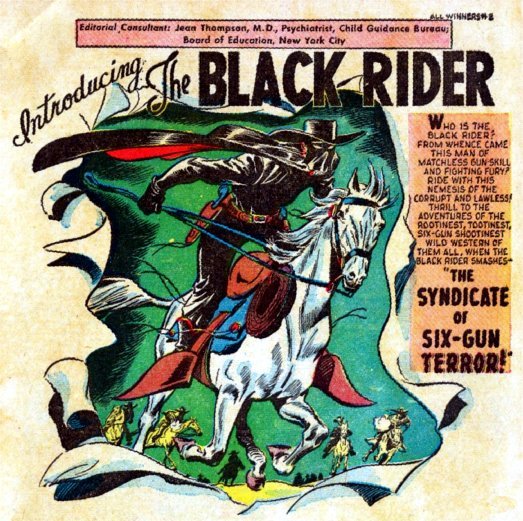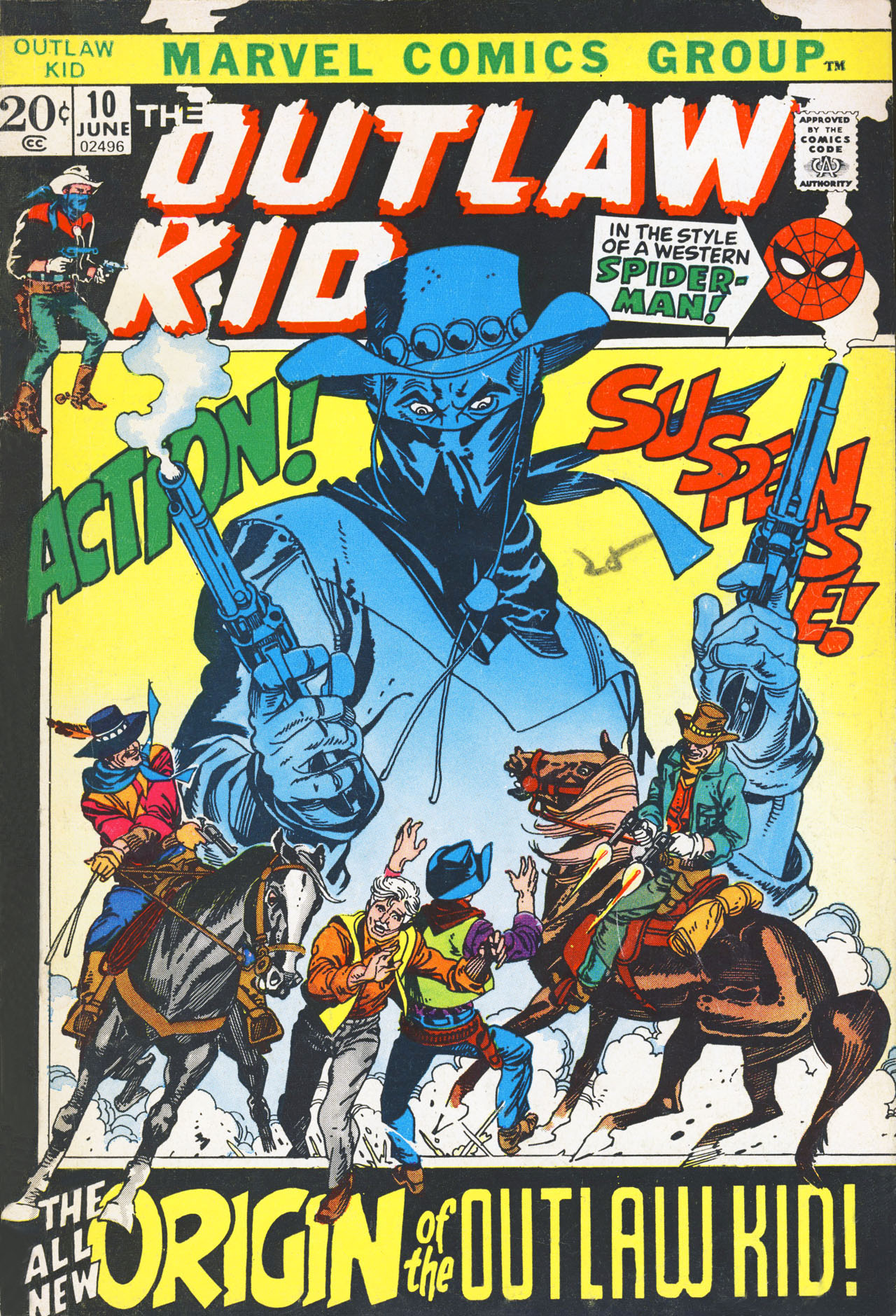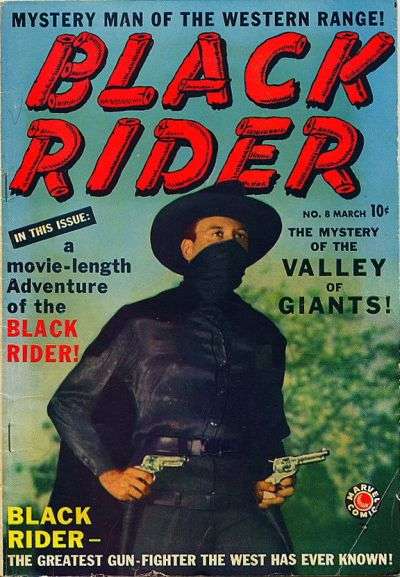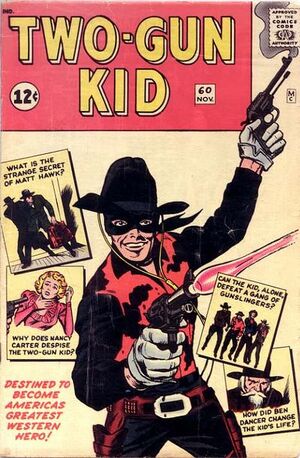CBR just recently did a Comics Legends post on comic photo covers, and this one was prominent. Seriously, how often do you get to see Stan Lee dressed up as a Western hero? And how could I resist re-posting it here?
At some point I hope to do a quick thumbnail history of the Black Rider...but I need to research him first! I think I have only ever read one of his tales!
Results 16 to 30 of 90
-
01-16-2017, 11:47 AM #16
 "Age is not defined by years, but by regrets...I'm an old man now." --Fighting Yank, "Project Superpowers"
"Age is not defined by years, but by regrets...I'm an old man now." --Fighting Yank, "Project Superpowers"
-
02-02-2017, 11:55 AM #17BANNED

- Join Date
- Nov 2014
- Location
- Marvel Studios
- Posts
- 13,533
-
02-18-2017, 08:26 AM #18

Happy Birthday Joe Maneely!

I have mentioned before how much I love his artwork. What a shame he died at such an early age. If he had lived on into the Marvel Years, I think his name would be right up there with Stan Lee, Jack Kirby and Steve Ditko."Age is not defined by years, but by regrets...I'm an old man now." --Fighting Yank, "Project Superpowers"
-
02-18-2017, 05:33 PM #19BANNED

- Join Date
- Nov 2014
- Location
- Marvel Studios
- Posts
- 13,533
 Happy Birthday to the late GREAT Joe Maneely!!!
Happy Birthday to the late GREAT Joe Maneely!!!
-
03-09-2017, 07:33 PM #20

I have finally finished my research into the Black Rider
He first appeared in All Western Winners # 2, Winter 1948
Matthew Masters was the Black Rider. His background is a little convoluted. In Texas, the Davis Gang ran wild. A young cowboy calling himself “the Cactus Kid” came to town, went to the local saloon, got on the wrong side of the Davis Gang--and killed them all. Later, the governor of Texas, seeing that the Cactus Kid is young (17 years old), gives him amnesty--because, you know, all he did was kill a bunch of people--and he convinces the kid to give up his life as a cowboy. The kid (Masters) promises to never use a gun or take a life again. He decides to become a doctor.

Time passes. He becomes a doctor and sets up shop in Leadville.
Yeah. Leadville. No foreshadowing there!
Masters meets Jim Lathrop, his daughter Marie and her boyfriend, who was wounded by Blast Burroughs. Apparently people fall in love with Marie fairly regularly. The boyfriend did, and Masters does. And then Burroughs enters the office and asks Marie to marry him. When she refuses, he kills the boyfriend. Lathrop asks Masters to help track down Burroughs, but true to his promise Masters states he has no gun. Marie is not impressed. Lathrop goes out and gets wounded too. This gets Marie to call Masters a coward.
Later, Masters is still conflicted between the feeling he should do something and the feeling that he should keep his promise. Then he learns that Burroughs is planning to burn down the Lathrop ranch. Grabbing his old guns, Masters breaks into a merchandise store and creates a disguise for himself. (Don’t worry: he left money to pay for the garb.) He cals himself the Black Rider. He gets his horse, Ichabod, and re-names the horse “Satan.”
Now these western comics do tend to have wonder horses, and Ichabod/Satan is one of those. This horse knows how to modify his personality as a disguise. When he is with Masters as Ichabod, he is a mild-mannered, sleepy horse. But when he is ridden by the Black Rider, he is a fiery stallion.
Anyway, the Black Rider rescues Marie and kills Burroughs and, surprise surprise, Marie instantly falls in love with the masked man. He is so heroic, unlike that cowardly Doctor Masters.

And so the Black Rider goes on to fight for justice in the Old West. Eventually, Marie’s brother Bobby will accidentally learn Masters secret. He keeps the secret but gets great fun out of playing on Marie disliking Doc Masters while loving the Black Rider.
In later stories, the Black Rider’s history was retconned a little to state that Masters parents were killed when he was 5 by a looter named Luke Davis. This is what motivates him to become the Cactus Kid and he eventually tracks down Luke Davis and shoots him dead. I suppose the thought was that that would explain his wholesale slaughter of the Davis Gang later.
The Black Rider’s publishing history is also convoluted. He started in All Western Winners # 2 (there was no “All Western Winners #1...the first issue was just called All Winners #1 had featured such characters as the Torch and Toro, Sub-Mariner and Captain America & Bucky--so quite a change between the two issues). By issue # 5 it was just called “Western Winners.” Western Winners #7 did NOT feature the Black Rider, but then the next issue was re-titled “Black Rider #8”--which is the photo cover with Stan Lee disguised as the Rider that was posted earlier in this thread. “Black Rider” went from #8 to #27, when it changed to “Western Tales of Black Rider” for issues #28 to #31. Issue #31 was dated November 1955.
The book got renamed “Gunsmoke Western” (for issues #32 through #77) but the Black Rider only appeared in issues #s 47 and 51, as a backup feature. He also appeared in backup stories in “Wild Western” between 1949 and 1957, as well as in “Kid Colt Outlaw,” “Ringo Kid” and “Two-Gun Kid” (as well as a couple other omnibus titles) in the 1950s.
In 1957, there was “Black Rider Rides Again!”--but it appears to have only lasted one issue. For all practical purposes, the character was done. Marvel reprinted some of his stories in “Western Gunfighters” #s 3-16 in the early 1970s. In 2006, he was in another one-shot “The Mighty Marvel Western featuring Strange Westerns starring the Black Rider.”
 "Age is not defined by years, but by regrets...I'm an old man now." --Fighting Yank, "Project Superpowers"
"Age is not defined by years, but by regrets...I'm an old man now." --Fighting Yank, "Project Superpowers"
-
04-06-2017, 06:41 PM #21BANNED

- Join Date
- Nov 2014
- Location
- Marvel Studios
- Posts
- 13,533
 Happy Birthday to the late GREAT Gil Kane!!!
Happy Birthday to the late GREAT Gil Kane!!!
-
04-20-2017, 11:42 PM #22BANNED

- Join Date
- Nov 2014
- Location
- Marvel Studios
- Posts
- 13,533
-
04-21-2017, 10:43 AM #23Moderator

- Join Date
- May 2014
- Posts
- 2,522

I always like Peter Gillis's Caleb Hammer. Whatever happened to Gillis? He was pretty talented. (According to Wikipedia, Caleb Hammer died -- in an issue of X-Force, of all places.)
Sandy Hausler
-
04-21-2017, 08:18 PM #24

I am afraid there is a tendency, when using the Western heroes in current comics, to kill off characters. As I think I commented earlier, while I love Ostrander's writing, his stories did run up a fairly high body count. That is the danger of limited series: because they are designed to be limited, there is a pressure to do something momentous in them. And, for Marvel, "something momentous" is just a synonym for "kill a character." That is why I would like an ongoing Western series--something that keeps the characters alive rather than aims to bury them all.
But I agree with you about Peter Gillis. He showed great ability and I wish he were still writing comics."Age is not defined by years, but by regrets...I'm an old man now." --Fighting Yank, "Project Superpowers"
-
04-28-2017, 07:55 PM #25

Happy Birthday, Dick Ayers!
 "Age is not defined by years, but by regrets...I'm an old man now." --Fighting Yank, "Project Superpowers"
"Age is not defined by years, but by regrets...I'm an old man now." --Fighting Yank, "Project Superpowers"
-
05-26-2017, 12:55 AM #26BANNED

- Join Date
- Nov 2014
- Location
- Marvel Studios
- Posts
- 13,533
-
06-07-2017, 06:35 PM #27

Happy Birthday, Pete Tumlinson!
 "Age is not defined by years, but by regrets...I'm an old man now." --Fighting Yank, "Project Superpowers"
"Age is not defined by years, but by regrets...I'm an old man now." --Fighting Yank, "Project Superpowers"
-
08-13-2017, 11:12 AM #28BANNED

- Join Date
- Nov 2014
- Location
- Marvel Studios
- Posts
- 13,533

Cool!
Indeed!Attachment 41246
The character was created in 1954, first appearing in Ringo Kid Western asa well as having stories in Wild Western as well. Ringo Kid Western ran for 21 issues (August 1954 to September 1957). Some internet sources state that the series dropped the word “Western” after the first issue, while others claim that “Western” was only included in the first and third issues. The truth is that the covers clearly show it being called Ringo Kid Western for the first four issues before the word “Western” was dropped. However, I find it useful to refer to the whole run as Ringo Kid Western to distinguish it from the 1970s reprint by Marvel (under the name of The Ringo Kid)
The Ringo Kid is the son of a white man (Cory Rand) and a Comanche woman (Dawn Star). Now in the books sometimes the Kid was called part Cherokee rather than part Comanche, but the Official Handbook of the Marvel Universe opted for Comanche. Frankly, I kind of like the idea that Dawn Star was half Comanche and half Cherokee--lots of story potential there if the Kid is both Comanche and Cherokee (as well as white...I guess “both” was a poor choice of words). Frankly, I am amazed that, in 1954, any publisher took the risk on a hero of “mixed race.” In the mid-fifties, several states would have considered interracial marriage (as happened between Cory Rand and Dawn Star) to be illegal and immoral. And yet here was Marvel’s predecessor, Atlas Comics, dedicating a book to the offspring of such a union! Kudos for them!
An odd but also to me intriguing mixBut back to his story: While tutored by his white father, the Ringo Kid also learned the Comanche ways. He did not know there was such a thing as racial prejudice until, in 1868, he went into town and was treated poorly because of his mixed heritage. Then, as the origin story goes, a man named Shad Rathburn begins whipping Ringo. Cory Rand kills Rathburn to avenge his son. Now an outlaw, Rand flees. Rathburn’s men also seek revenge and kill Dawn Star and burn the Rand family home. They caught Rand and were about to lynch him when the Ringo Kid came to the rescue of his father, killing Rathburn’s men. This, in turn, made him an outlaw as well.
This created the dynamic of a father-son duo, both outlaws, who try to keep apart to minimize the chance of both being captured, but who frequently would come to each other’s aid when needed. In essence, the comic merge both the lonesome rider trope of Westerns with a family unity trope. It is an odd mix. The two live separate lives but were loyal to each other. The Kid’s childhood friend, Dull Knife, would also be added to the mix.
Thank you for sharing all this info appreciate it.Attachment 41247
The “outlaw” brand would slowly change over time as more and more people in authority came to respect the loyalty and sense of justice of the Kid and his father. Eventually, the Ringo Kid was only technically an outlaw with nobody really trying to bring him to justice.
It is not clear who actually “created” the character of the Ringo Kid. The author of the first stories appears to be unknown. At least, I have found no definitive source giving a name of the writer. The first artist, though, was Joe Maneely. Maneely was a key component of Atlas Comics in the 1950s. He was not only a good artist, but a fast one! He had quite a dynamic art style (as is obvious from the covers I am posting--click for a larger image). Legend has it that he was quite a minimalist when it came to pencils, doing most of his art work in the inking stage. It is an odd technique, but it certainly worked! He is credited as co-creator (with Stan Lee) of the original medieval Black Knight as well as (with Al Feldstein) the characters of yellow Claw and his adversary Jimmy Woo. And, of course, he must be considered a co-creator of the Ringo Kid along with Anonymous. Sadly, he died in a tragic accident in June of 1958, leaving behind a wife and three daughters.
Attachment 41245
-
08-15-2017, 06:42 PM #29

My pleasure. It may take a little while, but I plan (eventually) to do a post concerning the reprint history of the Ringo Kid.
I also have been trying to write up a quick history of the Outlaw Kid...but it is so convoluted that it makes my head ache.
And a few other topics on the back burner."Age is not defined by years, but by regrets...I'm an old man now." --Fighting Yank, "Project Superpowers"
-
09-02-2017, 01:45 PM #30

Okay, this is going to be confusing. My focus is on Lance Temple.
In January 1951, a comic hit the stands with the following story:
Link Cado and his gang hunt down a man named Zane Temple, a former Texas Ranger. Zane, living on his ranch outside Caliber City, is warned of their approach and orders his son, Lance, to take his mother and hide in the shed. However, during the gunfight, a stray bullet goes through the shed, killing her. Cado also manages to shoot Zane in the back. Before he can kill Zane, though, Emilio Diaz and Red Hawk arrive and drive him off. Red Hawk is able to save Zane’s life, but Zane will be blind for the rest of his life. Diaz and Red Hawk stay at the ranch helping to raise Lance and teaching Zane how to function as a blind man.
As an adult, because his father has come to believe that violence solves nothing, Lance (although wanting revenge) makes a promise to his father that so long as he carries the name Temple, he will never use a gun against another man. Emilio Diaz and Red Hawk find a loophole in this arrangement: They give Lance a horse named Thunder and a disguise he can wear to get his revenge--he can keep his promise to his father by operating under a different name: The Texas Kid. As the Texas Kid, Lance Temple tracks down Link Cado, confronts Cado's gang and guns them all down.
That was the story from Texas Kid, #1. The book ran for ten issues (January 1951 to July 1952), most with Joe Maneely art. Lance Temple/Texas Kid would also make 5 appearances in “Two Gun Western” (issues #8-12, also in the 1951-52 period). And 3 appearances in “Wild Western” (issues #23-25) later in 1952.

Note: The Texas Kid is not to be confused with “The Kid from Texas,” a very short-lived 1957 series, featuring Dan Hawk.) He is also not to be confused with “The Texas Kid, Robin Hood of the Range” (otherwise unnamed) who made one appearance in January 1940 (“Daring Mystery Comics”).
The Texas Kid would go on to hunt down (and kill) a renegade named Howling Wolf; rescues some people from a slave trader; capturing (and, later, killing) an outlaw named Cahill; tracking down and killing “the Phantom of Massacre Gulch”; and so on. He would generally operate outside the town of Caliber City, and have such supporting characters as girl friend Belle.
But, basically, the character appeared only in 1951 & 1952, and then disappeared. Sort of.
In September of 1954, a comic hit the stands with the following story:
Zane Temple, a former U.S. Marshal (rather than a Texas Ranger) and his young son Lance are hard at work at their ranch outside Caliber City when riders from town come to warn Zane that Link Cado is looking to settle the score with him. Zane tells Lance and his wife to get into the back of the house (instead of a shed) for protection. However when Cado and his men arrive and the bullets begin to fly, a stray shot goes through the house and strikes Zane's wife killing her. Cado also sneaks up behind Zane and shoots him in the back. Emilio Ruiz and Red Hawk arrive in time to drive off Cado. Red Hawk manages to save Zane’s life, but Zane will be blind for the rest of his life. Emilio and Red Hawk stay and help Zane adapt to his new life and help raise Lance.
As an adult, Lance learns that Link Cado is still on the loose and wants to avenge his mother and father. Zane stops him, making Lance vow to never use violence and leave the fighting to others.
Lance’s friends, Emilio Diaz and Red Hawk, give him a horse named Thunder and Lance figures he can keep his promise to his father by developing a masked identity: the Outlaw Kid. He then goes and guns down Cado and his gang.
That was the story from The Outlaw Kid #1. Now this was NOT a reprint. The art was done by Doug Wildey (not Maneely), but the script was essentially the same as Texas Kid #1 with only minor variations. The interesting thing, though, is that from here on, it does not look like any other Texas Kid stories were re-done. I mean, because of basic Western tropes, many stories have similar themes, but it looks like the only true “re-telling” of a story was the origin. Mind you, Lance Temple, the Outlaw Kid, also lived in Caliber City and had a girlfriend named Belle, as well as his friends Diaz and Red Hawk. So, basically, all the details are the same as the Texas Kid except for his masked name.
It would be interesting if a legitimate comics historian (and not some duffer like me) looked into exactly why Atlas/Marvel chose to revive the character of Lance Temple under a new name and totally ignore his previous existence as the Texas Kid. The original artist/creator, Joe Maneely was still around and working for Atlas. Indeed, he did many of the covers for the book. He didn’t die until June of 1958. The Outlaw Kid originally ran for19 issues from September 1954 to September 1957, generally with Doug Wildey art inside.

So what was the thinking? Did calling him “Texas Kid” seem too regional? Not as exciting as “Outlaw Kid”? Did Daring Mystery Comics claim a copyright violation because they had “the Texas Kid” as a character in one issue in 1940? I don’t know. However, officially, Marvel does not consider the Texas Kid to be the same person as the Outlaw Kid, despite all the similarities. Just a coincidence, folks. Nothing to see here.
Anyway, in the 1970s, Marvel began to put out a number of Western comics, many of which relied on just reprinting stories from the 1950s. The Outlaw Kid was one of these, revived s Volume 2. For the first 9 issues, it is just a reprint book running stories from the 1954-1957 run.
Until issue #10.
Apparently the reprints were selling better than expected, so the decision was made to try some new stories. In issue #10, a new origin is written by Mike Friedrich. Now, Lance Temple is depicted as a veteran of the Civil War who returned home to live with his father, Hoot Temple. Lance would be a frontier lawyer as well as work the family ranch. One day, when the Temples were riding together, they were ambushed by outlaws. Dynamite exploded nearby and Hoot was blinded. Lance wanted to hunt down the outlaws, but Hoot made him promise that he would never use again use a gun because it was violence that had injured him and he didn't want a similar or worse fate to befall his son. Once again, Lance (like a true lawyer) finds a loophole in the agreement and creates the identity of the Outlaw Kid so that he, Lance, wasn’t the one using guns.
As you can see, the revised origin is similar to the original origin, but with a few changes. No more dead wife/mother. No Emilio Diaz, no Red Hawk. No more “blindness caused by being shot in the back” (And how exactly did that work anyway??? What the heck does being shot in the back have to do with eyesight? Maybe that is part of why they re-did the origin!).
Anyway, after this, new stories by Mike Friedrich would occur through #12. After that, Gary Friedrich would take over with new stories in issues #13 through #16. And because nothing is ever straightforward in the history of Lance Temple, it turns out that Gary Friedrich is no relation to Mike Friedrich. Just a coincidence, folks. Nothing to see here.
After issue #16, probably because of falling sales, The Outlaw Kid would return to being a reprint book (reprinting both the 1950s Outlaw Kid as well as some of the new 1970s stories) through issue #30, when it was cancelled.
In Blaze of Glory, John Ostrander relates that eventually Lance’s father learned that Lance was the Outlaw Kid. The shock killed the old man. This tragedy caused Lance to develop a split personality, in which Lance believes the Outlaw Kid to be somebody else, and is hunting him down for having killed his father. (Yeah, bonkers.) When a mask covers his face, he becomes the Outlaw Kid, when the mask is removed, he becomes Lance. Along with many other Western heroes, he would die in Blaze of Glory. As far as I can tell, he has remained dead."Age is not defined by years, but by regrets...I'm an old man now." --Fighting Yank, "Project Superpowers"









